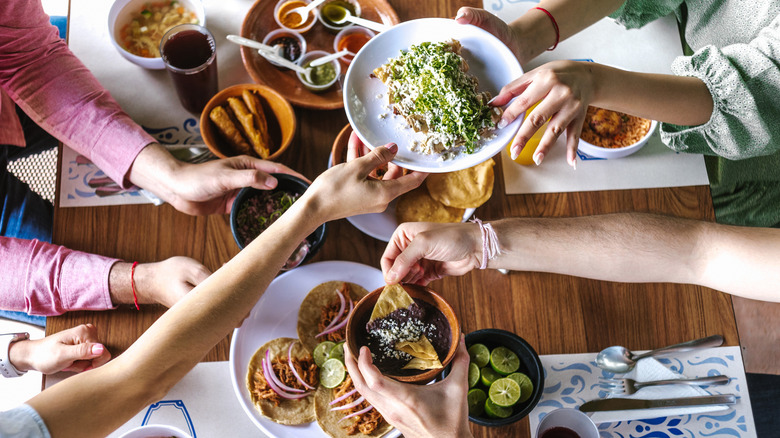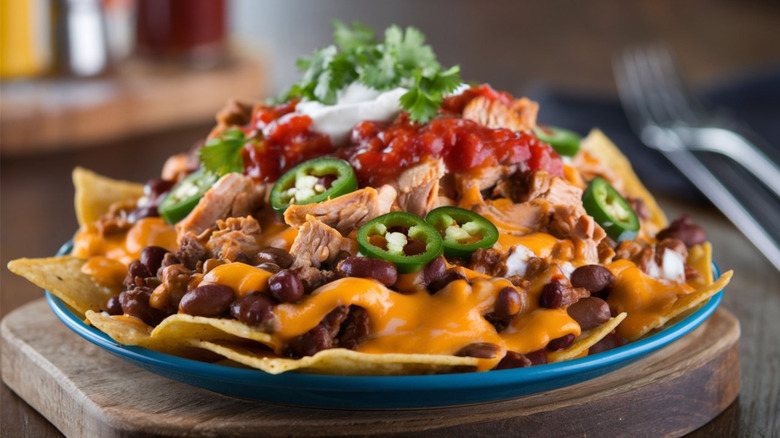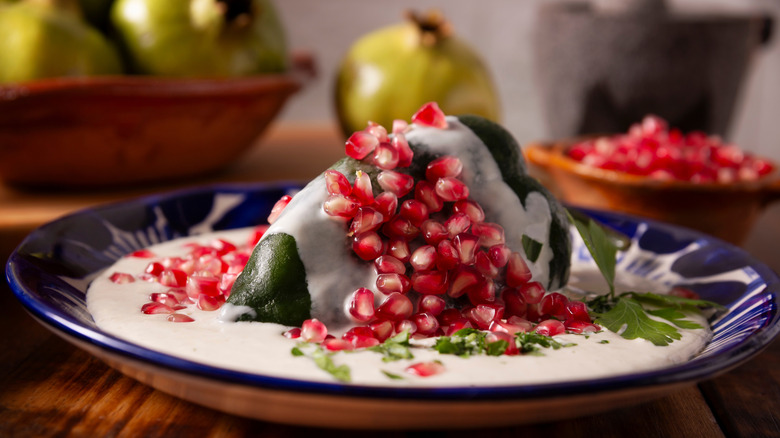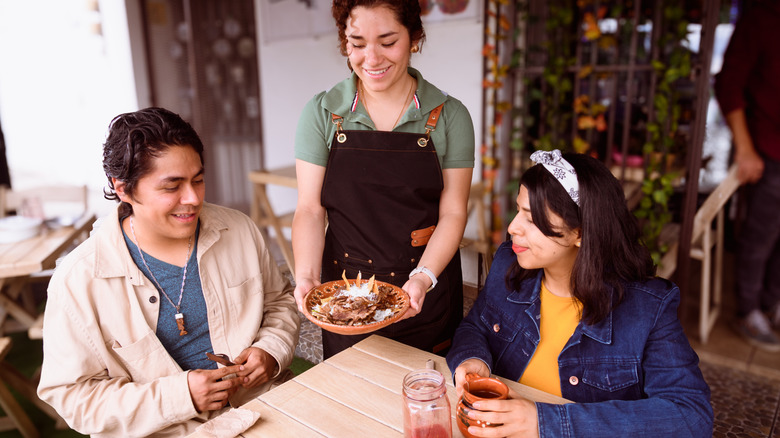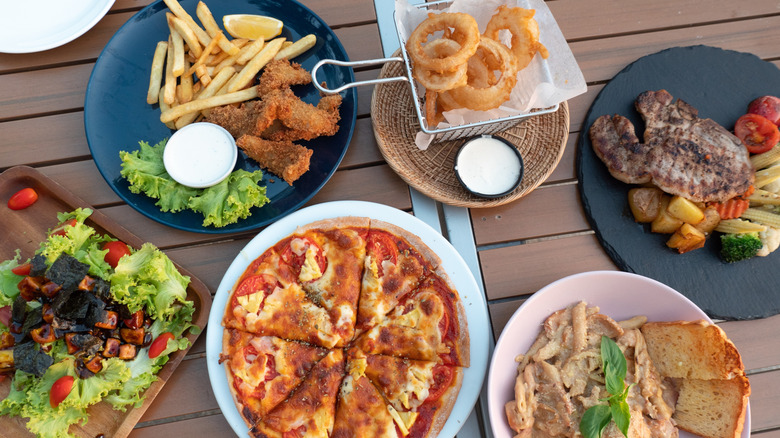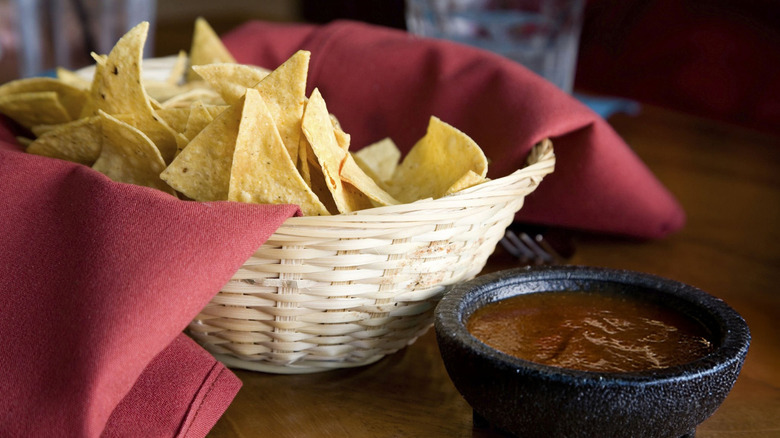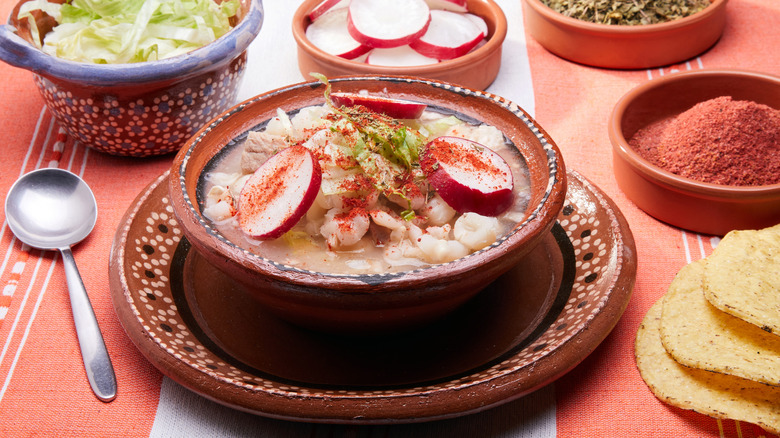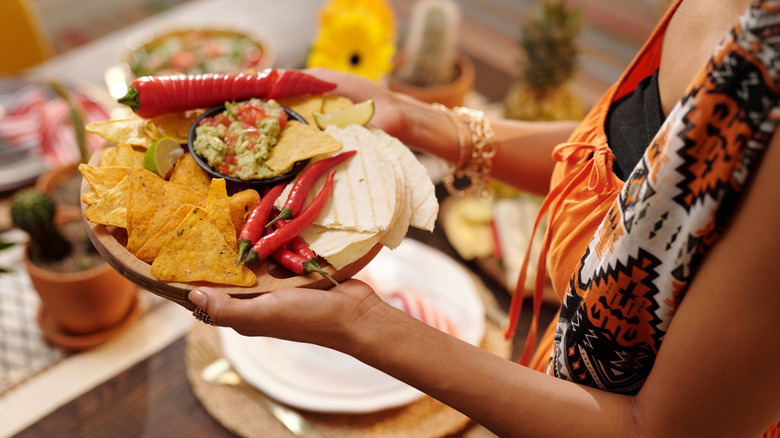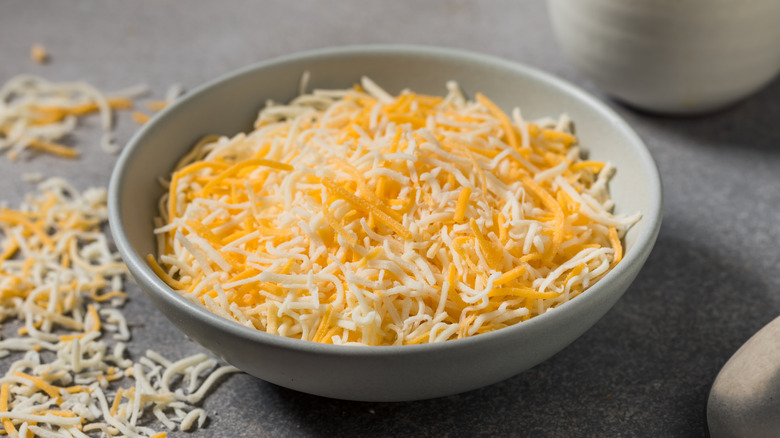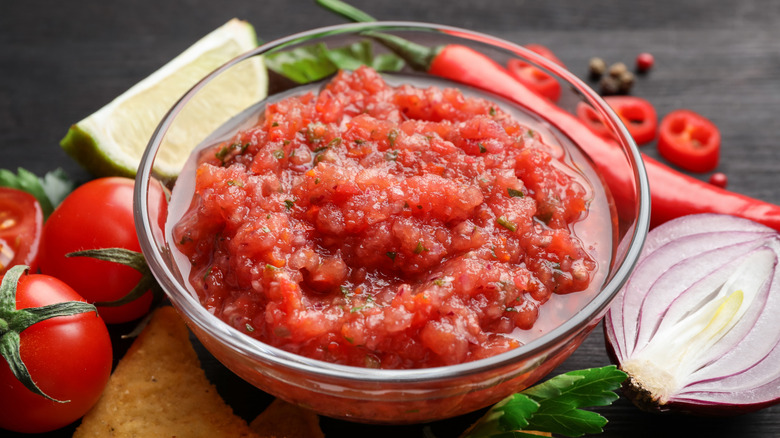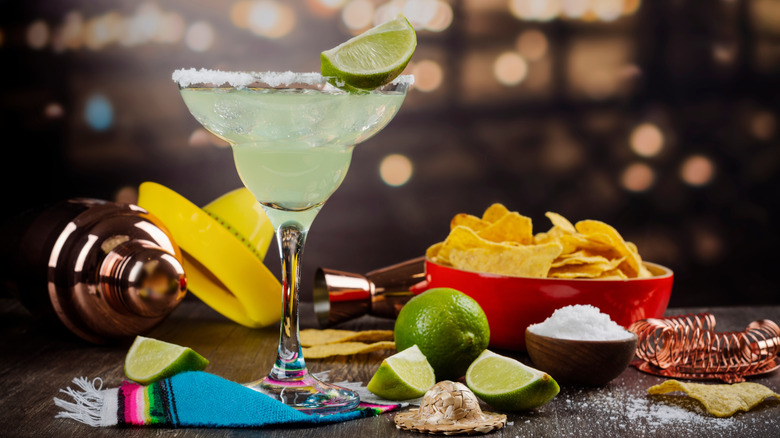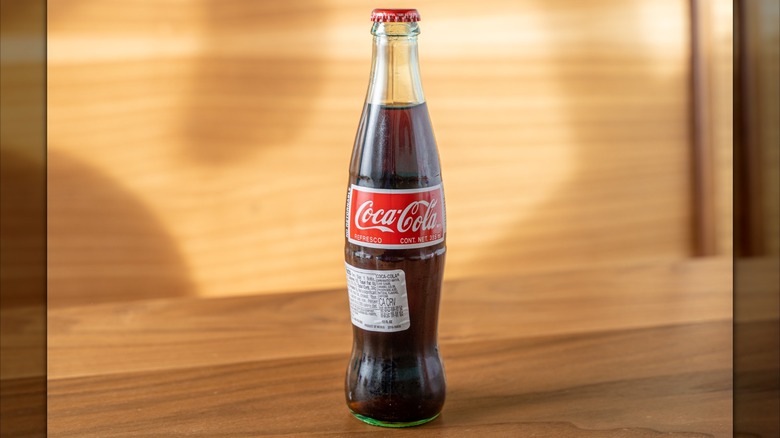Things You Should Avoid Doing At A Mexican Restaurant
Is it your first time visiting a Mexican restaurant? Or perhaps you've visited plenty, but always feel like you're doing something slightly wrong. Maybe that's ordering the wrong item or eating your dishes incorrectly. Whatever it is, you're not alone in this feeling. Having lived in California most of my life, I've been to my share of Mexican restaurants and even worked at one. After all, California and Texas are the two U.S. states that boast the most Mexican restaurants. And through these experiences, I've discovered there are cultural nuances to visiting a Mexican joint.
Fortunately, having some background knowledge can help you appreciate the experience so much more. From how you order and season your food to what you do (or don't) ask for on the side can make a big difference. But don't worry. This guide isn't about being overly cautious, but helping you respect the culture and enjoy those tacos and tamales to the fullest. So if you're heading to a Mexican restaurant soon, avoid these 14 foodie faux pas.
Confusing Tex-Mex with authentic Mexican cuisine
When many people in the United States think of Mexican cuisine, their mind immediately goes to Tex-Mex. While we love this fusion, there's a big difference between Tex-Mex and authentic Mexican cuisine. Expecting one over the other can lead to serious disappointment.
As a border state, Texans are well-acquainted with Mexican cuisine, but they've added their own unique element to it. Thanks to a large ranching community, Tex-Mex uses beef far more than traditional Mexican proteins like chicken or seafood. It also incorporates yellow cheeses, while authentic Mexican cuisine favors white cheeses, veggies, and hot chiles, and tends to have a stronger kick.
Another difference between Tex-Mex and Mexican restaurants is the taco shells. Tex-Mex tortillas are usually made from wheat flour, while Mexican ones come from corn — and corn tortillas made in-house are a giant green flag to look for in an authentic Mexican restaurant. Meanwhile, hard-shell tacos are controversial because their origin is not entirely clear. In Mexican homes or restaurants, you'll find tacos dorados, aka flautas, that are made from deep-fried corn tortillas. But those pre-made hard-shell tortillas you see at the grocery store? They're considered Tex-Mex.
Ignoring regional cuisines
You probably have your go-to Mexican dish, but when visiting a new restaurant, don't be surprised if it's missing from the menu. This doesn't mean the restaurant is any less authentic. Mexico's food culture is shaped by seven distinct culinary regions, so the restaurant may simply focus on a slightly different cuisine. Each area has its own flavor identity and local ingredients, and chefs say there are many regional Mexican foods everyone should try, from Puebla's chiles en nogada to the Yucatan's tamales colados. So, if your favorite enchilada isn't on the menu, don't be afraid to explore a whole new region's menu.
What can you expect from Mexico's diverse culinary regions? Up north, you'll find ranch-style cooking with grilled meats, refried beans, and hearty flour-tortilla burritos. Baja California is a seafood lover's paradise with its quintessential fish tacos, while the Bajío region features cotija cheese, carnitas, and arroz con leche. Central Mexico is home to Mexico City, where street food abounds, and wherever you turn, you'll find stands with tasty tacos and tortas.
Further south, Oaxaca and the Pacific coast celebrate indigenous ingredients like corn, cacao, and black beans. The Gulf region, including Veracruz and Tabasco, embraces its tropical roots with plantains and yucca. Meanwhile, the Yucatán Peninsula fuses Mayan, Caribbean, and global influences into bold, colorful dishes.
Ordering specials without asking questions
Unsure what to order at a Mexican restaurant? It's tempting to default to the specials. After all, if they're special, they must be good, right? Well, not always. In many restaurants, specials can be a clever way to repurpose excess ingredients like that chicken that isn't selling well or that fish nearing its shelf life. It's like those clean-out-the-fridge meals you make before a big grocery shopping trip.
That said, some specials really are special. When a chef creates a new dish to showcase seasonal ingredients or experiment with flavors, it's often worth trying. And if it's a limited-time offering, you won't get another chance. So, how do you know the difference? One way is to ask your server questions. Many restaurants have staff taste the specials before service, so they can offer honest feedback. Ask which dishes stand out or how the special compares to the regular menu options. If staff isn't a fan of the special, they probably won't outright bash it. But a good server will gently steer you in the right direction and save you from an overpriced leftover remix.
Always sticking to dishes you know
Some of the most popular Mexican dishes in the United States are fajitas, burritos, and chimichangas. While these are delicious, there are far more options out there, and if you're constantly ordering the exact same thing, you're missing out. Sure, that go-to enchilada is a safe bet. But by stepping out of your comfort zone, you might just discover a new favorite.
One of the best things you may not have tried at a Mexican joint is sope, a thick corn masa cup piled high with beans, meats, cheese, and salsa. You should also try tlayudas, Oaxaca's version of pizza made with crispy tortillas and refried beans. Chiles en nogada is another satisfying creation made of poblano peppers stuffed with meat and fruit and topped with creamy walnut sauce. Feeling more adventurous? Try menudo, a rich red chile tripe stew, or chapulines, aka grasshoppers.
Visiting a restaurant is also the perfect opportunity to sample complicated Mexican dishes that just aren't worth making at home. Things like chiles rellenos and tacos al pastor can take hours to prepare but mere minutes to devour. So if you see one of these complex dishes on the menu, don't hesitate to branch out.
Ordering non-Mexican items off an eclectic menu
A long, sprawling menu might seem like a good thing at first. But truthfully, long restaurant menus are red flags at any type of establishment. When you see everything from pizza to sushi, we'd question the quality, especially at a Mexican restaurant. Those non-Mexican items — like burgers, pasta, or wings — often exist just to appease picky eaters in a group, not because the kitchen actually excels at them.
Let's get real, nobody is visiting Mexican joints for their spaghetti. It's a completely different cuisine. And trying to master multiple cuisines in one kitchen can be confusing. Authentic spots know their strengths, and they stick to them. Their energy goes into perfecting dishes like enchiladas, tamales, and tacos, not whipping up a last-minute cheeseburger. So next time you're eyeing the menu, skip the oddball options and focus on what the kitchen does best. Even if you're not big on beans and rice, you can still find plenty of variety at Mexican restaurants, from zesty ceviche to tortilla soup.
Asking for too many substitutions
In the U.S., customizing your meal is widely accepted. No onions, dressing on the side, and extra avocado? No problem! But at a traditional Mexican restaurant, taking substitutions too far can backfire. Mexican dishes are carefully balanced, often designed to combine bold, contrasting flavors. Mole poblano, for example, is rich, smoky, sweet, and slightly spicy all at once. Remove the chocolate or chile, and you lose the harmony of the dish.
Remember, most authentic Mexican restaurants aren't designed like Chipotle. You're not building your own burrito bowl. The chef has intentionally layered those flavors and textures to create a specific experience. Too many custom requests can disrupt that balance. Plus, a half page of substitutions can make customizing your order at a restaurant downright rude.
This said, a small tweak or two is often fine. If you'd rather have corn tortillas instead of flour, or prefer chicken over beef, you'll still get a satisfying dish. The key is knowing when a substitution changes the essence of what you're ordering. If you're unsure where to draw the line, ask your server what's flexible and what's best left as is.
Overloading on the tortilla chips before your meal
Overloading on tortilla chips is a fairly obvious mistake. It's also one of the many customer requests employees hate most at Mexican restaurants. Yet, we do it far too often. You sit down at a table, and before you've even opened the menu, a basket of warm tortilla chips and fresh salsa appears. Suddenly, your hand-to-mouth reflex takes over, and before you know it, you're halfway through your second basket. It's an easy trap considering that salty crunch is oh-so-satisfying. But the problem isn't the chips themselves, but what they do to your appetite.
By the time your tacos, enchiladas, or fajitas arrive, you're already full. And eating your main course on a stuffed stomach never hits the same. So the next time that tortilla chip basket magically appears in front of you, pace yourself. Snack a little, savor the salsa's flavors, and stop while you're ahead. If the server offers complimentary refills, politely decline, and save that appetite for the main attraction. Trust us, your future self will thank you.
Expecting Mexican cuisine to be simple
Many people make the mistake of assuming Mexican cuisine is simple: rice, beans, tacos, and maybe a burrito or two. But that couldn't be further from the truth. Yes, Mexican restaurants have a familiar warmth and easy-going nature, but that doesn't equal simplicity. Mexican food is actually one of the most complex and layered cuisines in the world. While it's primarily influenced by Indigenous and Spanish cuisine, it's also been shaped by African, Middle Eastern, French, and German cultures.
Many Mexican comfort dishes have a rich history, being passed down from generation to generation. They often take hours of preparation, which includes slow roasting or simmering sauces with dozens of ingredients. Mole, for example, isn't just a spiced chocolate sauce for chicken. There are more than 50 types, and traditional mole poblano can include over 30 ingredients, from dried chiles and nuts to starches, spices, and, of course, cacao. Meanwhile, pozole, a hearty hominy stew, dates all the way back to the ancient Aztecs. It can take anywhere from several hours to several days to prepare. And while there are three basic varieties — green, red, and white like the Mexican flag — the flavors of any given pot vary widely.
Assuming all Mexican food is spicy
One of the biggest misconceptions about Mexican food is that it's all spicy, and if you're not a fiery food fan, you should stay away. Of course, chiles are a staple ingredient in the country's cuisine, but not all chiles are spicy, and they're used for flavor just as much as heat. As a result, many classic Mexican dishes are mild, creamy, or even sweet.
Those who can't handle spice may enjoy enchiladas suizas, which are baked in a rich, cheesy cream sauce rather than a fiery red one. Meanwhile, tamales are all about the masa's buttery texture and have several non-spicy fillings like shredded pork or beans and rice. Even tacos are typically mild, and it's the extra salsas and hot sauces that set them ablaze. Guacamole, rice, and refried beans are more staples that rarely bring heat, and can help offset any spiciness you do encounter in other dishes.
For those who do crave a spicy kick, Mexican cuisine has plenty of options. Aguachile is a spicy seafood lover's dream, while camarones a la diabla (devil's shrimp) will have your mouth on fire. You can also top traditional tacos al pastor with salsa roja or a spoonful of smoky chipotle sauce. Truth be told, the spiciness of Mexican food varies — even when ordering the same dish. So, don't hesitate to ask your server whether your meal will be mild, medium, or mouth-burningly hot.
Expecting a side of shredded cheese
At home, taco night might mean piling on handfuls of shredded cheddar or a mountain of orange cheddar. However, that's more of a Tex-Mex or Americanized Mexican trend. In a real Mexican restaurant, you probably won't find a side of shredded cheese at all, especially not the bright yellow kind.
Yellow cheese is actually a telltale sign you're not at a traditional Mexican restaurant. In Mexico, cheese tends to be white and used more sparingly than Tex-Mex joints would lead us to believe. A common cheese used in Mexican cuisine is queso fresco, a soft, crumbly variety with a light, tangy flavor that adds freshness to tacos and enchiladas. Cotija, on the other hand, is firmer and saltier — you'll often find it sprinkled on top of elotes (grilled corn) or beans. Other traditional cheeses include Oaxaca (a melty, mozzarella-like cheese) and panela (a mild, cheese excellent for grilling).
So, if your enchiladas arrive blanketed in a thick layer of yellow cheddar, you're probably at an Americanized joint. However, that's not necessarily a bad thing. If you're enjoying those flavors, that's all that matters. But if you're in an authentic Mexican restaurant anxiously awaiting that side of shredded cheese, you may be waiting forever.
Smothering everything in salsa or hot sauce
Salsa and hot sauce are integral parts of the Mexican culinary experience, adding flavor and fire to many dishes. But there's a fine line between enhancing your meal and bulldozing it. When used in excess, that vibrant pico de gallo or super spicy hot sauce can overpower the other flavors. Forget picking up on subtle hints of cumin, oregano, or coriander; all you taste is tomato and capsicum. And if you're overzealous with hot sauce, that decision may come back to bite you later on.
Before dousing your dish, we'd also check the quality of those condiments. Fresh, house-made salsa should taste bright and balanced, and never cold or dull. Chilled salsa at Mexican restaurants could mean it's mass-produced and pulled from the refrigerator. With hot sauces, restaurants often have a selection of familiar brands on the table. Ideally, they'll also offer house-made hot sauces, which will taste far fresher. But just remember: You can't gauge spiciness off sight alone. To prevent a fiery meltdown, do a little taste-test before drizzling it on your food.
Splurging on margarita pitchers before testing quality
A chilled margarita pairs perfectly alongside salty chips, spicy salsa, and hearty entrees. But if you're at a Mexican restaurant for the first time, don't leap straight into a full pitcher. Start small and test the waters. Not all margaritas are created equal, and if a restaurant cuts corners with store-bought mixers, that margarita could taste overly sweet or artificial. And there's nothing worse than realizing a few sips into a giant pitcher that it tastes like melted popsicles.
Before diving into that pitcher, order a single glass first. You can even pass it around the table for a quick taste test before committing. If it's balanced, fresh, and tangy, you've found a winner. If not, you've just saved yourself (and your wallet) from disappointment. And if you're going booze-free, avoid ordering virgin margaritas at Mexican joints. It's basically paying a premium for fancy limeade. Instead, order a flavorful agua fresca or a Mexican Coke.
Thinking Mexican Coke is a gimmick
Coca-Cola is an American product and one of the most famous exports. So when you see Mexican Coke on a menu, you might wonder if it's just rebranded American Coke, making that higher price feel like a gimmick. However, we assure you — there's a real difference between the two, and Mexican Coke might be worth the extra cost.
Mexican Coke is believed to be superior to American Coke because it's made with cane sugar rather than high-fructose corn syrup, resulting in a cleaner, crisper flavor. You still get that same familiar fizz, but with a subtly smoother sweetness that doesn't leave a syrupy aftertaste. Then there's the glass bottle, which adds a nostalgic touch and enhances the flavor. Unlike plastic or aluminum, glass doesn't affect the taste, so every sip feels fresher. Plus, holding a glass soda bottle and hearing it clink against the table just hits differently. You also rarely see glass-bottled sodas anymore, so if you spot Mexican Coke on the menu at your local taquería, go ahead and splurge.
Not checking reviews before picking the restaurant
Trying a new Mexican restaurant can be exciting, but it can also be a gamble. Without a trusted recommendation, you might end up with a plate of soggy enchiladas, watered-down margaritas, or a generally disappointing experience. Plus, not every place advertising authentic Mexican food delivers the real deal. Some are Americanized knockoffs with an overpriced menu and mediocre meals hiding behind colorful decor.
To avoid disappointment, take a few minutes to research before you go. Check Yelp, Google Maps, or TripAdvisor for recent reviews. Or, for a quick summary of places to avoid, check out our list of the worst Mexican restaurant chains according to customer reviews. See what diners are saying not just about the food, but the service, cleanliness, and consistency — and don't just focus on the negatives. Reviews can help you discover hidden gems and your new favorite dish, so look for places that customers rave about and see what they recommend ordering.
